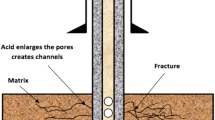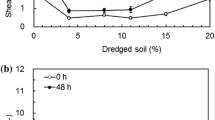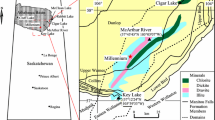Abstract
The similarity of the fine fraction of dredged freshwater sediments to natural clays stimulates the valorization in a product similar to expanded clay aggregates, obtained by bloating at high temperature. The impact of the ratios between different flux elements (Fe2O3 + CaO + MgO + K2O + Na2O) on the melting behavior is quantified using thermodynamic modeling and validated with experiments. The total content of alkalis is found to be key in controlling melting and bloating. Increased alkali content triggers the formation of alkali feldspars that start to melt at low temperature and give rise to a gradual increase of the amount of melt with temperature. The ratio (CaO + MgO + K2O + Na2O)/Al2O3 should preferably be smaller than or close to 1 to avoid excessive pyroxene formation, which causes complete meltdown of the granules around 1150 °C. The chemical composition has a complex influence on the melting behavior, even when on the same location on the SiO2–Al2O3–flux diagram. The conventional approach of trying to modify the composition towards a certain range in the ternary diagram does not work for all materials, and therefore, the understanding of the melting behavior using the phase composition at high temperature (= the metallurgical approach) provided in this work is shown to be crucial to produce lightweight aggregates from materials with a higher chemical variability.
Graphical Abstract


















Similar content being viewed by others
References
European Dredging Association (2005) Dredged Material & Environmental Regulation in EU. European-dredging.eu/Publications. Accessed August 2020
Henry M, Brequel H, Meerseman J, Lemiere B (2019) Mineral processing techniques dedicated to the recycling of river sediments to produced raw materials for construction sector. In: Proceedings of the 11th SedNet Conference, Dubrovnik, Croatia, April 2019
Snellings R, Cizer O, Horckmans L, Durdzinski PT, Dierckx P, Nielsen P, Van Balen K, Vandewalle L (2016) Properties and pozzolanic reactivity of flash calcined dredging sediments. Appl Clay Sci 129:35–39
Benzerzour M, Amar M, Abriak N (2017) New experimental approach of the reuse of dredged sediments in a cement matrix by physical and heat treatment. Constr Build Mater 140:432–444
Kazemi-Kamyab H, Van den Abeele L, Henry M, Haouche L, Snellings R (2019) Evaluation of calcined dredged sediments as supplementary cementitious materials. In: Proceedings of the 2nd International Conference of Sustainable Building Materials, 12–15 August 2019, Eindhoven, The Netherlands
Amar M, Benzerzour M, Kleib J, Abriak N (2021) From dredged sediment to supplementary cementitious material: characterization, treatment, and reuse. Int J Sedim Res 36(1):92–109
Hung M, Hwang C (2007) Study of fine sediments for making lightweight aggregate. Waste Manage Res 25:449–456
Wei Y, Yang J, Lin Y, Chuang S, Wang HP (2008) Recycling harbor sediment as lightweight aggregate. Mar Pollut Bull 57:867–872
Wang H (2009) Durability of self-consolidating lightweight aggregate concrete using dredged silt. Constr Build Mater 23:2332–2337
Tang C, Chen H, Wang S, Spaulding J (2011) Production of synthetic lightweight aggregate using reservoir sediments for concrete and masonry. Cement Concr Compos 33:292–300
Chen H, Yang M, Tang C, Wang S (2012) Production of synthetic lightweight aggregates from reservoir sediments. Constr Build Mater 28:387–394
Huybrechts D, Meynaerts E, Van Hoof V, Hooyberghs E, Vrancken K (2008) Beste Beschikbare Technieken (BBT) voor de kleiverwerkende nijverheid. Academia Press, Gent
Decleer J, Viaene W (1993) Rupelian Boom clay as raw material for expanded clay manufacturing. Appl Clay Sci 8:111–128
Riley CM (1951) Relation of Chemical Properties to the Bloating of Clays. J Am Ceram Soc 34(4):121–128
Conley JE, Wilson H, Klinefelter TA (1948) Production of lightweight concrete aggregates from clays, shales, slates, and other materials. Technical report for the US Department of the Interior and Bureau of Mines.
Cougny G (1990) Specifications for clayey raw materials used to produce expanded lightweight aggregates. Bull Int Assoc Eng Geol 41:47–55
Battle TP, Hager JP (1990) Viscosities and activities in lead-smelting slags. Metall Trans B 21:501–510
Mills KC (1993) The influence of structure on the physico-chemical properties of slags. ISIJ Int 33(1):148–155
Jak E, Hayes PC, Lee H (1995) Improved methodologies for the determination of high temperature phase equilibria. Met Mater 1:1–8
Tripathi G, Malfliet A, Blanpain B, Guo M (2019) Dissolution behavior and phase evolution during aluminum oxide dissolution in BOF slag. Metall and Mater Trans B 50:1782–1790
Chen L, Malfliet A, Jones PT, Blanpain B, Guo M (2019) Influence of Al2O3 level in CaO–SiO2–MgO–Al2O3 refining slags on slag/magnesia-doloma refractory interactions. Metall and Mater Trans B 50:1822–1829
Schupsky JP, Guo M, Blanpain B, Müller M (2020) The impact of sample homogeneity, crucible material, and oxygen partial pressure on the crystallization of Fe-rich oxidic slag in CSLM experiments. J Sustain Metall 6:216–226
Cheeseman CR, Virdi GS (2005) Properties and microstructure of lightweight aggregate produced from sintered sewage sludge ash. Resour Conserv Recycl 45:18–30
Mueller A, Sokolova SN, Vereshagin VI (2008) Characteristics of lightweight aggregates from primary and recycled raw materials. Constr Build Mater 22:703–712
Chiou I, Wang K, Chen C, Lin Y (2006) Lightweight aggregate made from sewage sludge and incinerated ash. Waste Manage 26:1453–1461
Cheeseman CR, Makinde A, Bethanis S (2005) Properties of lightweight aggregate produced by rapid sintering of incinerator bottom ash. Resour Conserv Recycl 43:147–162
Cunning PJ, Hills CD, Carey PJ (2009) Production of lightweight aggregate from industrial waste and carbon dioxide. Waste Manage 29:2722–2728
Yang C, Cui C, Qin J (2015) Recycling of low-silicon iron tailings in the production of lightweight aggregates. Ceram Int 41(1B):1213–1221
Chuang K, Lu C, Chen J, Wey M (2018) Reuse of bottom ash and fly ash from mechanical-bed and fluidized-bed municipal incinerators in manufacturing lightweight aggregates. Ceram Int 44(11):12691–12696
Ennahal I, Maherzi W, Benzerzour M, Mamindy Y, Abriak N (2020) Performance of lightweight aggregates comprised of sediments and thermoplastic waste. Waste Biomass Valorization. https://doi.org/10.1007/s12649-020-00970-1
Moreno-Maroto JM, Gonzalez-Corrochano B, Alonso-Azcarate J, Rodriguez L, Acosta A (2018) Assessment of crystalline phase changes and glass formation by Rietveld-XRD method on ceramic lightweight aggregates sintered from mineral and polymeric wastes. Ceram Int 44(10):11840–11851
Bale CW, Bélisle E, Chartrand P, Decterov SA, Eriksson G, Gheribi AE, Hack K, Jung IH, Kang YB, Melançon J, Pelton AD, Petersen S, Robelin C, Sangster J, Spencer P, Van Ende MA (2016) FactSage thermochemical software and databases, 2010–2016. Calphad 54:35–53
Bradski G (2000) The opencv library. Dr Dobb’s J Software Tools 25:120–125
Bernhardt M, Tellesbø H, Justnes H, Wiik K (2013) Mechanical properties of lightweight aggregates. J Eur Ceram Soc 33(13–14):2731–2743
Bernhardt M, Tellesbø H, Justnes H, Wiik K (2014) The effect of heat treatment and cooling rate on the properties of lightweight aggregates. J Eur Ceram Soc 34(5):1353–1363
Acknowledgements
This research was possible by financial support of the Interreg V France-Wallonie-Vlaanderen project VALSE.
Author information
Authors and Affiliations
Corresponding author
Ethics declarations
Conflict of interest
The authors declare that they have no conflict of interest.
Additional information
The contributing editor for this article was João António Labrincha Batista
Publisher's Note
Springer Nature remains neutral with regard to jurisdictional claims in published maps and institutional affiliations.
Supplementary Information
Below is the link to the electronic supplementary material.
Rights and permissions
About this article
Cite this article
Peys, A., Van De Sande, J., Teck, P. et al. A Metallurgical Approach Toward Bloating of Canal-Dredging Sediments. J. Sustain. Metall. 7, 1671–1685 (2021). https://doi.org/10.1007/s40831-021-00441-4
Received:
Accepted:
Published:
Issue Date:
DOI: https://doi.org/10.1007/s40831-021-00441-4




